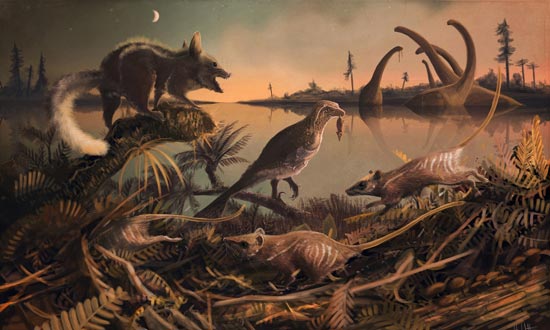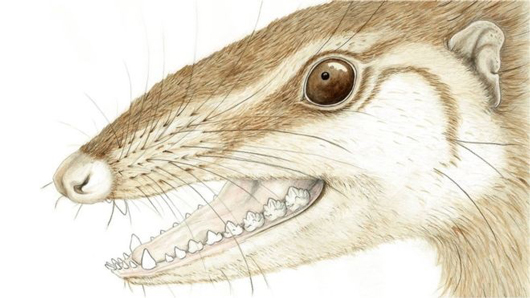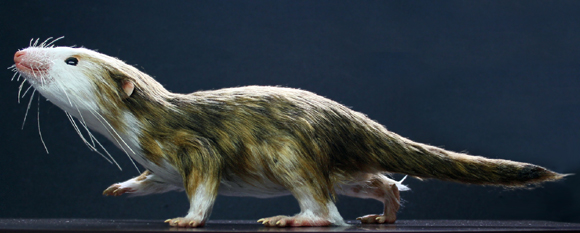Tiny Fossils Reveal How Shrinking Was Essential for Successful Mammalian Evolution
Mammals and dinosaurs may have shared a common reptilian ancestor, but these two tetrapod lineages diverged from one another a very long time ago. However, mammals lived alongside the dinosaurs for many millions of years and a new study published in the academic journal “Nature”, suggests that staying small and inconspicuous was a key factor contributing to the evolution of mammals. It was only after the extinction of the dinosaurs and other types of reptile, pterosaurs and marine reptiles, for example, that mammals were able to grow much larger.
Mammals and Dinosaurs
Most Mammals Remained Small During the Mesozoic and Many were Probably Nocturnal

Picture credit: Mark Witton
The Origins of Mammals
There are three types of mammals living today, there are the monotremes, the egg-laying mammals such as the platypus and the echidna, remnants of a once very widespread and diverse group of egg-laying mammals called the Australosphenida, that existed in the Southern Hemisphere for much of the Jurassic and Cretaceous. Secondly, there are the pouched mammals, the marsupials, familiar creatures such as kangaroos, possums, koalas and such like. Thirdly, there are the much more common and geographically widespread placental mammals (humans are a placental mammal).
The first true mammals such as the Late Triassic Eozostrodon, Megazostrodon and Morganucodon lived over 200 million years ago and a team of scientists from the United States and the UK have concluded that whilst the dinosaurs grew into giants, the ancestors of all modern mammals opted for a different strategy, they stayed small.
A Life Reconstruction of the Morganucodont Morganucodon of the Late Triassic
Picture credit: University of Birmingham
Getting to Grips with the Mammalian Jaw
The researchers used modern computer analysis to examine what happened to the skeleton of our tiny, shrew-like mammal ancestors. Modern mammals have a unique lower jaw, consisting of a single bone that bears teeth (the dentary). In contrast, other vertebrates have more complex lower jaws formed by several bones fused together.
In the course of the evolution of mammals, the complex jaws became simplified and a new jaw joint was formed, whilst some of bones that once formed the back of the jaws (the articular in the lower jaw and the quadrate in the back of the upper jaw), became much reduced in size, moving to the middle ear to evolve a role to aid hearing.
For an article that looks at the evolution of hearing in the mammaliaform and true mammals: Let’s Hear It For Mammalian Evolution.
A Transitional Process
The scientists looked at how it was possible for the jaw to be restructured, whilst the animal was still able to feed and to hear. X-ray computed tomography (CT scans) were employed to assess the skulls and jaws, computer models were then built to simulate the evolutionary process. The team’s results showed that the small size of the fossil mammals significantly reduced the stresses in the jaw bones when feeding, while still being powerful enough to capture and bite through prey, such as insects.
Early Mammals were Small and Shrew-like

Picture credit: Elsa Panciroli
Mammalian Jaw Evolution
Commenting on the study, lead author and lecturer at Birmingham University, Dr Stephan Lautenschlager stated:
“Our results provide a new explanation of how the mammalian jaw evolved over 200 million years ago. Getting very small appears to have been crucial for our mammalian ancestors. This allowed them to reduce the stresses in the jaw during feeding and made the restructuring of the jaw bones possible.”
Professor Emily Rayfield (Bristol University), who lead the study added:
“The evolution of the mammalian jaw joint has perplexed palaeontologists for over 50 years. Using computational methods, we can offer explanations to how our mammalian ancestors were able to maintain a working jaw while co-opting bones into a complex sound detection system. Our research is about testing ideas of what makes mammals unique among the animal kingdom, and how this may have come about.”
The scientific paper: “The Role of Miniaturisation in the Evolution of the Mammalian Jaw and Middle Ear” by Stephan Lautenschlager, Pamela Gill, Zhe-Xi Luo, Michael J. Fagan and Emily Rayfield published in the journal Nature.
Everything Dinosaur acknowledges the assistance of a press release from the University of Birmingham in the compilation of this article.
Visit the Everything Dinosaur website: Everything Dinosaur.








Leave A Comment